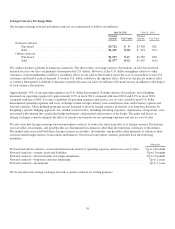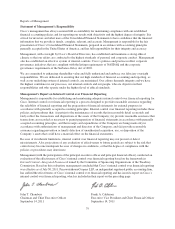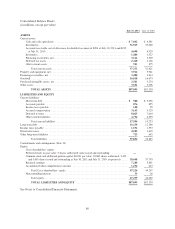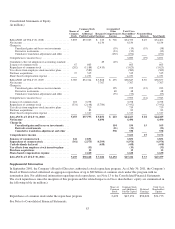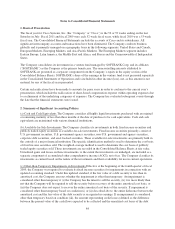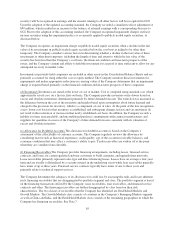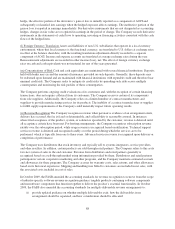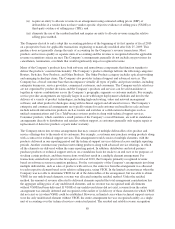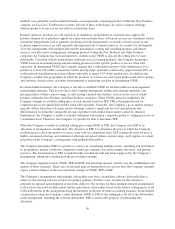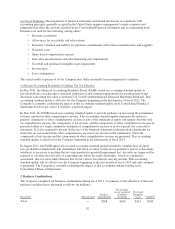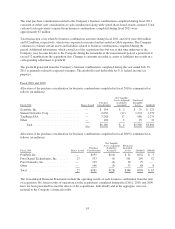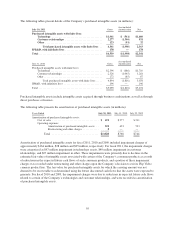Cisco 2011 Annual Report Download - page 93
Download and view the complete annual report
Please find page 93 of the 2011 Cisco annual report below. You can navigate through the pages in the report by either clicking on the pages listed below, or by using the keyword search tool below to find specific information within the annual report.
security) will be recognized in earnings and the amount relating to all other factors will be recognized in OCI.
Upon the adoption of the updated accounting standard, the Company recorded a cumulative effect adjustment of
$49 million, which resulted in an increase to the balance of retained earnings with a corresponding decrease to
OCI. Prior to the adoption of this accounting standard, the Company recognized impairment charges on fixed
income securities using the impairment policy as is currently applied to publicly traded equity securities, as
discussed below.
The Company recognizes an impairment charge on publicly traded equity securities when a decline in the fair
value of its investments in publicly traded equity securities below the cost basis is judged to be other than
temporary. The Company considers various factors in determining whether a decline in the fair value of these
investments is other than temporary, including the length of time and extent to which the fair value of the
security has been less than the Company’s cost basis, the financial condition and near-term prospects of the
issuer, and the Company’s intent and ability to hold the investment for a period of time sufficient to allow for any
anticipated recovery in market value.
Investments in privately held companies are included in other assets in the Consolidated Balance Sheets and are
primarily accounted for using either the cost or equity method. The Company monitors these investments for
impairments and makes appropriate reductions in carrying values if the Company determines that an impairment
charge is required based primarily on the financial condition and near-term prospects of these companies.
(d) Inventories Inventories are stated at the lower of cost or market. Cost is computed using standard cost, which
approximates actual cost, on a first-in, first-out basis. The Company provides inventory write-downs based on
excess and obsolete inventories determined primarily by future demand forecasts. The write-down is measured as
the difference between the cost of the inventory and market based upon assumptions about future demand and
charged to the provision for inventory, which is a component of cost of sales. At the point of the loss recognition,
a new, lower cost basis for that inventory is established, and subsequent changes in facts and circumstances do
not result in the restoration or increase in that newly established cost basis. In addition, the Company records a
liability for firm, noncancelable, and unconditional purchase commitments with contract manufacturers and
suppliers for quantities in excess of the Company’s future demand forecasts consistent with its valuation of
excess and obsolete inventory.
(e) Allowance for Doubtful Accounts The allowance for doubtful accounts is based on the Company’s
assessment of the collectibility of customer accounts. The Company regularly reviews the allowance by
considering factors such as historical experience, credit quality, age of the accounts receivable balances, and
economic conditions that may affect a customer’s ability to pay. Trade receivables are written off at the point
when they are considered uncollectible.
(f) Financing Receivables The Company provides financing arrangements, including leases, financed service
contracts, and loans, for certain qualified end-user customers to build, maintain, and upgrade their networks.
Lease receivables primarily represent sales-type and direct-financing leases. Leases have on average a four-year
term and are usually collateralized by a security interest in the underlying assets while loan receivables generally
have terms of up to three years. Financed service contracts typically have terms of one to three years and
primarily relate to technical support services.
The Company determines the adequacy of its allowance for credit loss by assessing the risks and losses inherent
in its financing receivables that are disaggregated by portfolio segment and class. The portfolio segment is based
on the financing transactions offered by the Company: lease receivables, loan receivables, and financed service
contracts and other. The financing receivables are further disaggregated by class based on their risk
characteristics. The two classes of receivables that the Company has identified are Established Markets and
Growth Markets. The Growth Markets class consists of countries in the Company’s Emerging Markets segment
as well as China and India, and the Established Markets class consists of the remaining geographies in which the
Company has financing receivables. See Note 7.
85



